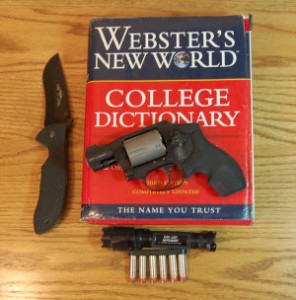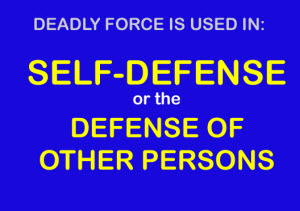
Tools for anyone prepared to defend themselves or their loved ones: a reliable gun, extra ammo, a good flashlight, a knife, and KNOWING THE RIGHT WORDS.
www.personaldefensenetwork.comBeing legally armed is a tremendous responsibility. You carry a tool that can take human life in an instant. Statistics show that most self-defense shootings happen in close quarters and at short distances. These shootings also usually happen in low-light conditions. The vast majority of scenarios involving deadly force unravel in a matter of a few seconds from start to finish.
Personal Experience
I have personally been involved in several shootings. In one case, I was holding onto the suspect when he pointed a gun at me. I literally shoved the gun in his side and fired. My part in this gunfight lasted about a second.
At the other end of the spectrum, I was among several officers who returned fire when a suspect came to our police headquarters and ambushed two rookie police officers coming in to work. One officer was killed and another severely wounded. More than 70 rounds were fired in the running gunfight at distances up to almost 100 feet. All this took less than 30 seconds from start to finish.
You can see that you do not have any time to waste. You must plan ahead for the fight, and prepare yourself mentally. You do not have time to hesitate.
It has been my experience that the greatest source of hesitation is not being mentally prepared. The two sources of that hesitation seem to be:
- Personal doubts about using deadly force based on religious or social concerns.
- Doubts about the laws regarding when deadly force can be used.
I addressed the first point in my article Deadly Force Decisions. Now let’s talk about the laws related to using deadly force.
The Law
Every state has laws concerning the use of deadly force. As a responsible citizen, you need to know those laws. Contact your State Attorney General for guidelines and publications. Seek information from official sources like your local police departments and prosecutor’s office.
Attend training classes, but be sure those classes are conducted by instructors certified in the use of deadly force. I have seen instructors who were not knowledgeable and certified on the topic talk about deadly force. Do not take a chance with your freedom by attending a class with an uncertified instructor.
Do not listen to the opinions of untrained and uncertified people when it comes to the use of deadly force. You must be confident that you are acting in a safe and legal manner. Your freedom is too important to take a chance with. Find good training. Get solid information from legitimate sources.
The gun culture we live in has many sources of information. Not all that information is correct. Websites can be started by anyone with a computer and a few dollars. Buddies standing around talking at a gun show may have the best intentions when they talk about the law. But are they trained? Do they really know what they’re talking about? I certainly would not want to go into court and have as my only defense, “The guys at the gun show said it was legal.”
As an instructor certified to teach deadly force to law enforcement personnel and civilians, I have seen some common guidelines that are used throughout the country. Remember, these are guidelines you can use to help prepare you before a deadly force decision. However, you still need to research and know the laws of the state where you live and anywhere you travel.
What Is Deadly Force?
Definitions differ from state to state, but here is a good general working definition: “Deadly force” means any force that carries a substantial risk that it will approximately result in the death of any person.
 Obviously, shooting someone is deadly force. Stabbing or cutting someone with a knife meets the definition of deadly force. There are many situations where a person can exert force that will likely cause death. The use of a car as a weapon is a common scenario police officers face. Getting run over could definitely kill you. Common everyday items can be used as weapons that can cause death. The determining factors are how the item is used and how the situation develops.
Obviously, shooting someone is deadly force. Stabbing or cutting someone with a knife meets the definition of deadly force. There are many situations where a person can exert force that will likely cause death. The use of a car as a weapon is a common scenario police officers face. Getting run over could definitely kill you. Common everyday items can be used as weapons that can cause death. The determining factors are how the item is used and how the situation develops.
If you carry a gun or knife for self-defense, you carry weapons capable of delivering deadly force. They are not intended to scare or intimidate. They are not intended just to make you “feel” safer. They are intended to give you the capability of delivering deadly force under the proper legal circumstances. You must be confident about when you can use those tools to defend yourself and the people you love.
Self-Defense and the Defense of Others
Most states only allow the use of deadly force in self-defense or the defense of others. Deadly force is not usually permitted to recover or protect personal property. You must be able to articulate, or explain, why you used deadly force.
I have taught my Deadly Force Decisions class to thousands of concealed carry students, police academy recruits, and seasoned law enforcement officers. When we discuss justifying the use of deadly force, one common statement I hear is, “All I have to do is say I was in fear for my life.”
These are not some magic words that allow you to use violence without any responsibility. The fact is that you must ARTICULATE, or explain, why you used deadly force. And that use of force must make sense to the people who will judge your actions.
Before that armed confrontation occurs, you must be set in your mind that you will use deadly force when legally permitted. You must also know what the law allows, so you do not hesitate at the moment of decision.
We all believe “It is better to be judged by 12 than carried by six.” When the smoke clears, you must be able to explain to those 12 peers why your actions were reasonable and prudent according to law. You must be able to articulate to responding law enforcement officers that what you did was justified.
Most states also permit the use of deadly force to protect a third party who cannot defend themselves. Once again, you must know the law, be set in your mind and prepared to act to defend the people you love.
 The general guideline is that an armed person may use force to protect an unarmed person as long as the situation would permit the unarmed person to use a gun if they had one available. In other words, the same rules apply when you defend someone else as when you defend yourself.
The general guideline is that an armed person may use force to protect an unarmed person as long as the situation would permit the unarmed person to use a gun if they had one available. In other words, the same rules apply when you defend someone else as when you defend yourself.
Let me make a strong suggestion here. Do not get involved in a situation unless you absolutely, positively know what is going on. Many times a situation is not as it appears. You could be walking into a very dangerous and difficult situation. Unless the person involved is a loved one or someone you know well, consider backing off and calling the police.
If you see any crime in progress, be the best witness possible. Get all the information you can, call 911 and get the professionals there to help. You may be very skilled and confident, but it is always better to send in the cavalry!
You could roll up to a convenience store one night and see a robbery in progress. You see a man at the counter pointing a gun at the clerk. Clearly this is a bad guy. You know police response times can be slow, so you decide to go in and stop the robbery. The problem is that you don’t see the second guy hiding behind the door with the sawed-off shotgun.
There is an exception to this advice. If you are in a situation where bullets are flying and people are dying, calling 911 alone may not be the proper response. An active shooter situation changes all the rules. That is why you must be both mentally and physically prepared to meet the threats of the modern world.
Start your mental preparation by watching the news. Read the newspaper. Pay attention to what is going on around you. When you see a story about a crime, think about how you would handle it if you were in that situation. Use these situations as your personal training scenarios. Talk things over with your family and loved ones.
In other words, get your best weapon ready — your mind!
There are more guidelines for using deadly force, and I will discuss them in part 2 of this article. Be sure to follow up for additional critical information about the use of deadly force.

I am not sure if i could shoot somebody or if i do shoot sombody what are my options
Where do I find my state laws on line?
Good article, you should address liability regarding use of deadly force, both criminal defense & civil liability protection, the difference between them, the differences in type & quality of coverage. You could be in a righteous shoot totally justified & be bankrupted by legal expenses. If that info is not covered you are doing a disservice to your readers
They're LAWS, not GUIDELINES.
I am searching for proper responses for properly trained, & tested volunteer security team members (ILEA qualified prior service), for riots/looters at our church or business in Indiana. I am also checking with my insurance agents to see if we are covered, because so Far my reading says NO.
Very educational!
Lt. Williams I'm very grateful for your articles, here in Puerto Rico however when you call Police they don't come period. They have been slapped with a deep blow in their retirement benefits and many are running for the hills at this moment. What to do if you know for certain they will not come?
If you see a policeman in a dangerous situation and overwhelmed, should you go to his aid or would that only put him in more danger?
Information and education must be very important and probably varies by state.
Rule number one is that you are not a cop. You have NO duty to pursue or intervene. Rule number two is it will be YOU that gets sued, YOU that pays for the lawyers, and YOU that pays for the counseling. Might be you that gets dead. Rule number three is get training, training and more training. You can buy a lot of excellent training for the price of one civil or criminal defense attorney.